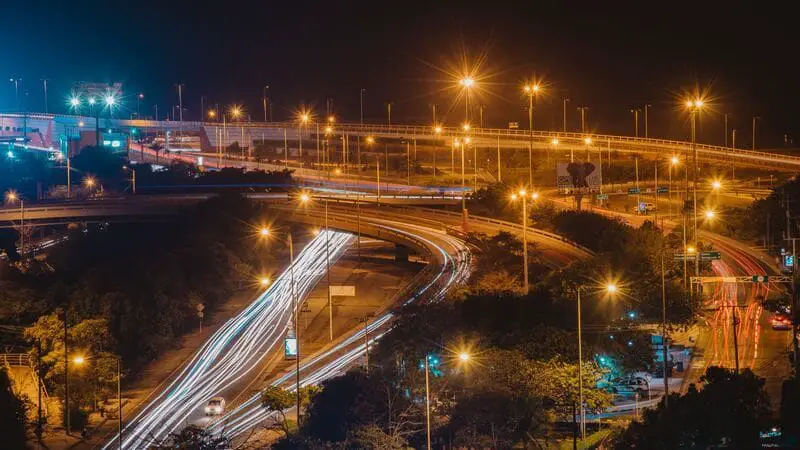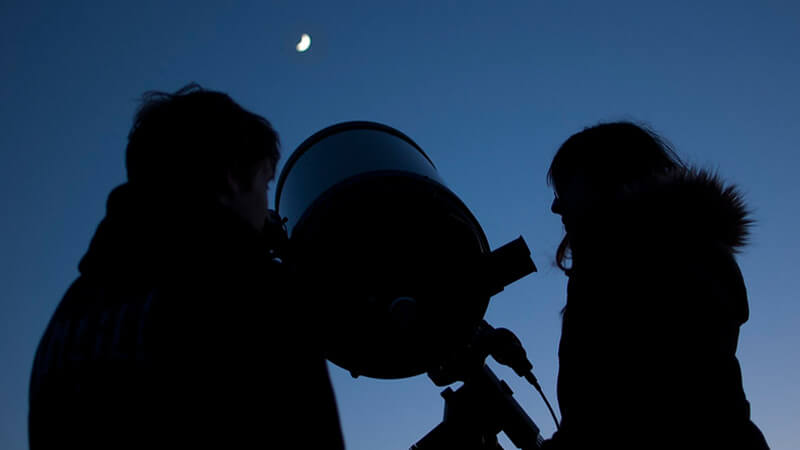Have you ever wondered, “Can you use a telescope in the city?” With so many bright lights and buildings, it might seem tricky. Fear not, my young stargazers! I’m here to guide you through the challenges and excitement of urban astronomy.
Yes, you can use a telescope in the city! While cities present some obstacles, like light pollution and atmospheric disturbances, we can still explore the night sky’s wonders with the right tools and techniques.
In a nutshell
Planning and preparing to make the most of your telescope experience in the city is essential! You’ll want to find a spot as high up as possible, like the roof of a tall building source, or even go on a stargazing adventure to a nearby park with less light pollution.
In this article, you get
Helpful advice on stargazing in the city, where artificial light obscures the visible light
A list of celestial objects you can observe from your city’s light polluted sky
Telescope accessories to improve their use in a light polluted city
Suggestions to improve your city stargazing experience
By the end of this article, you’ll have all the info you need to explore the night sky in the city and much more!
Let’s dive right in.
Can you use a Telescope in the City? Challenges of Urban Astronomy

As an amateur astronomer, enjoying stargazing in the city can sometimes be challenging.
In many locations, like Los Angeles, seeing the Milky Way with the naked eye has become nearly impossible.
Here, I’ll walk you through some of the main challenges you might face and provide tips to help you overcome them.
Light Pollution

One of the biggest challenges in urban astronomy is light pollution. City lights brighten the night sky, cause sky glow, and make it hard to see faint objects, like a star cluster or your favorite celestial object. Is there such as thing as a Dark Sky in the city?
To improve your city stargazing experience:
- Find dark spots in your city, like parks or open spaces
- Use a light pollution filter with your telescope
Air Pollution
Air pollution can also make it tricky to observe the night sky. Dust, smoke, and smog scatter light and reduce visibility. Here are some tips to minimize the effects of air pollution:
- Go stargazing after a rainstorm when the air is cleaner
- Choose high-elevation spots to avoid dense pollution closer to the ground
Atmospheric Turbulence
In cities, buildings and other structures can create atmospheric turbulence. Each star appears to twinkle. The turbulence can reduce the clarity of your observations.
To deal with atmospheric turbulence:
- Choose an observing location away from buildings and heat sources
- Observe on nights with steady airflow and gentle breezes
Now that you’re aware of these urban astronomy challenges and have some tips to overcome them, you’re one step closer to experiencing the beauty of the night sky in the city. In the next section, you’ll learn about the best equipment to use for urban stargazing.
Choosing the Right Telescope

When you want to stargaze in the city, picking the right telescope is crucial. In this section, I’ll help you understand different types of telescopes and their advantages, specifically for urban use.
We’ll look at refractors, reflectors, and Dobsonian telescopes.
Refractors
Refractor telescopes use lenses to gather light and focus it for viewing.
Some benefits of using a refractor telescope in the city are:
- They offer sharp and contrast-rich views
- Low maintenance, as the optics are sealed
- Suitable for observing the Moon and planets
However, they can be more expensive, and larger refractors might be less portable.
Reflectors
Reflecting telescopes use mirrors to collect and focus light.
Here are some reasons why it’s useful for city dwellers:
- Generally more budget-friendly
- Larger aperture for the same price as a refractor
- Get brighter and more detailed images of deep-sky objects
The downside is that they require more maintenance and can be less portable.
Dobsonian
Dobsonian telescopes are an adaptation of reflecting telescopes, but with a few strengths for urban amateurs:
- Super easy to use and set up
- Often large apertures at affordable prices
- Very stable so that you can enjoy a steady view
The main challenge is that a Dobsonian telescope can be bulky and occupy more space.
Now that you have a basic understanding of these three types of telescopes think about which one fits your needs and preferences the best. Consider your living situation, available space, and budget when deciding.
Let’s explore some tips to get the most out of your telescope under urban skies.
Observing Celestial Objects

Moon and Planets
You can still observe the Moon and planets quite well using a telescope in the city. Since these objects are relatively bright in our Solar System, even with light pollution, so they’re easy to see.
To check out the Moon’s surface, you can:
- Spot craters
- Identify markings
- Observe moon phases
You can see Mercury, Venus, Mars, Jupiter, and Saturn. Some planets even have moons you can observe, like Jupiter’s Galilean moons.
Galaxies and Stars
City lights make it harder to observe galaxies and stars with a telescope, but it’s not impossible. You might not see as many stars or the faint glow of a galaxy, but you can still enjoy some sights like:
- Double stars
- Bright open clusters
- A few nearby galaxies
To maximize your stargazing experience in the city, try to observe during nights with clear viewing conditions.
Nebulae and Deep Sky Objects
Nebulae and deep-sky objects are harder to see in cities since they are faint and require darker skies. However, keep hope!
There are a few tricks you can try:
- Use an eyepiece with a narrow wavelength of light to cut through light pollution.
- Observe from a high point in the city to reduce the impact of streetlights.
- Set up your telescope in a location that blocks direct line-of-sight light from your eyes and the eyepiece.
Remember, patience and persistence are key when observing celestial objects in the city. Now, let’s move on to tips for choosing the right equipment for urban stargazing.
Optimizing Telescope Performance
Even in a city, you can have a great experience observing the night sky. In this section, we’ll talk about optimizing your telescope’s performance in urban environments.
Filters and Accessories
To increase the quality of your views, you can invest in filters and accessories. One helpful filter is the light pollution filter, which helps block unwanted light from street lamps and outdoor lights. The variable polarizing moon filter is another filter for more detailed views of the Moon.
Here’s a list of valuable filters for city stargazing:
- Light pollution filter
- City light suppression filter
- Ultra-high contrast filter
- Variable polarizing moon filter
Telescope Mounts
A stable mount is essential for clear views. You have two main options: manual and computerized mounts.
Manual mounts are less expensive but require practice to track objects in the sky.
A motorized mount makes tracking objects much easier, especially in a city where viewing conditions may limit the visibility of celestial objects.
Eyepieces
Choosing the right eyepiece helps you see the most specific details in planets, comets, and asteroids.
A low-power eyepiece can provide a wider field of view, which makes it easier to find objects in the sky. For example, a low-power eyepiece would be perfect for locating planets like Uranus and Neptune.
It would help if you also had a high-power eyepiece in your collection to observe finer details using high magnification, for instance, Jupiter’s Great Red Spot or valleys on the Moon.
In summary, you can enhance your city stargazing experience by using the right filters, mounts, and eyepieces to adjust your magnification.
Next, we’ll discuss finding the best locations for observing the night sky in a city environment.
City Stargazing Tips
Finding a Suitable Location

When using a telescope in the city, you should first find a suitable location.
Light pollution can make it hard to see celestial objects, so:
- Look for areas with less lighting, like parks or hills.
- Avoid street lights by positioning yourself in the shadows.
- Head to a rural area or a nearby hill with lower light pollution.
Viewing from Balconies, Roofs, and Windows

Not everyone has access to the perfect location, but you can still stargaze from your balcony, roof, or window by:
- Elevating your telescope to minimize obstructions from buildings.
- Using a portable telescope for easy setup and transportation.
- Attaching a narrowband or anti-light pollution filter to reduce the effects of city lights.
Cooperation with Neighbors
Involving your neighbors can be beneficial for a better stargazing experience:
- Share your passion for astronomy and ask them to dim their lights during specific hours.
- Establish a dedicated stargazing spot in your neighborhood.
- Organize group stargazing sessions, making it a fun, educational, and social activity!
To make city stargazing more enjoyable and successful, remember to:
- Choose a telescope that’s easy to set up and transport.
- Learn about variable stars and other celestial objects visible even under light-polluted skies.
- Use filters and other accessories to maximize your telescope’s performance.
Summary: Telescope in the City
Thank you for reading my article “Can You Use a Telescope in the City?”
Using a telescope in the city is possible! Light pollution may be challenging, but anyone can enjoy stargazing with the right equipment and techniques.
When looking for a good spot in the city, try to find a high location with fewer lights. A rooftop could be a great place to set up your telescope. Always make sure to ask permission before accessing private areas. To enhance your city stargazing experience, consider using filters to reduce light pollution.
Here are some useful tips for city stargazing:
- Look for planets, the Moon, and bright stars (they’re easier to see in light-polluted areas)
- Avoid streetlights and other bright lights as much as possible
- Use a telescope with a smaller aperture (this helps reduce the impact of light pollution)
- Be patient and wait for the sky to darken after sunset
Remember, practice makes perfect! The more you practice using your telescope, the better you’ll become at spotting celestial objects in the city. Don’t get discouraged if city stargazing seems complicated at first; with time and effort, you’ll enjoy more and more of the night sky’s wonders.
In conclusion, exploring the cosmos is an exciting adventure. Don’t let city lights stop you from experiencing the beauty of the universe! You can become an expert city stargazer with the right tools, tips, and perseverance. So grab your telescope and embark on your journey among the stars.




